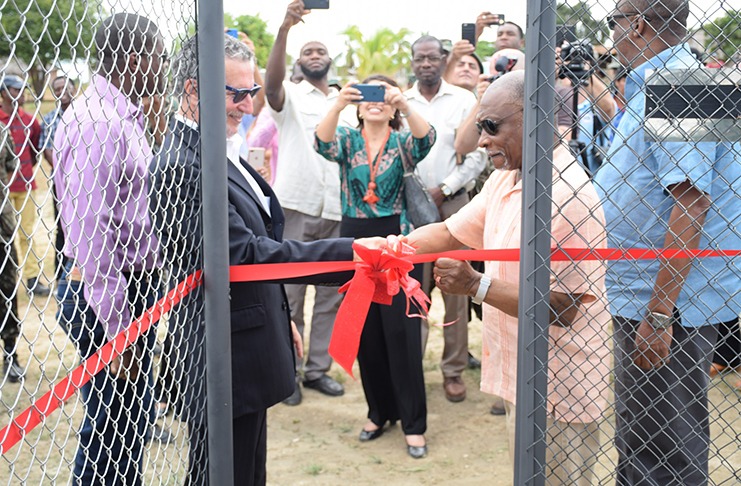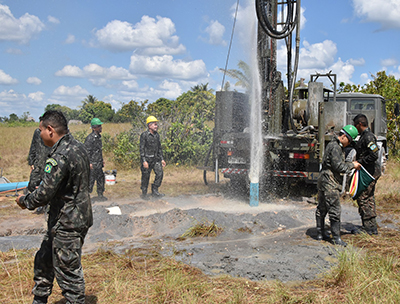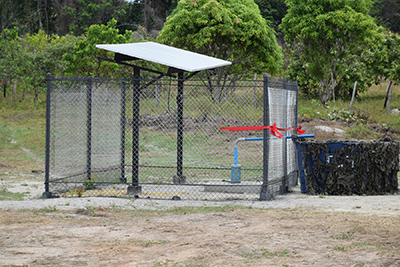NATURAL disasters are unpredictable and they are devastating. In Guyana, hundreds of villagers in the Upper Takutu- Upper Essequibo (Region Nine) are either displaced or suffer due to either flooding or extreme drought. In these instances, the Government is forced to face the economic consequences; directing scarce resources to relief efforts that would have otherwise been spent on improving social services and raising standards of living.

This stark reality necessitates that the country develops comprehensive disaster preparedness plans that are designed to lessen the impacts of a disaster. The adverse impact of natural disasters often cannot be fully prevented, but their scale or severity can be substantially lessened, by various strategies and actions. That is where the Basic Agreement on Technical Cooperation between the Government of the Co-operative Republic of Guyana and the Federative Republic of Brazil for the Implementation of the Project Technologies to Reduce the Effects of the Drought in Region Nine comes into play.
Following President David Granger’s State visit to Brazil in December 2017, where the Complementary Agreement was inked, the Civil Defence Commission (CDC) has been tasked with coordinating the project. In this week’s Government in Action, we look at the project, the progress being made in the drilling of the wells across the South Rupununi to reduce drought, how the project will benefit the villages and the unprecedented relief it will bring not only to residents but the regional administration.

Reducing the incidence of droughts in the Rupununi
The Complementary Agreement signed states that the Government of Brazil shall undertake to “promote the transfer of Brazilian knowledge and experience related to mitigation of the effects of drought; provide the means for implementation of activities foreseen in the project, send consultants and experts to implement activities to be carried out in Guyana, support the development of the Guyanese technical team’s capacity to drill artesian wells and monitor and evaluate project implementation.”

Meanwhile, the Government of Guyana, as prescribed in the Agreement, shall undertake to “take responsibility for the maintenance of the artesian wells that will be drilled during the practical operations on the ground; appoint a technical team to monitor and participate in activities to be implemented, provide the technical team sent by the Government of Federative Republic of Brazil with the logistical support required to implement activities of their responsibility and to take measures to ensure that activities implemented by professionals sent by the Brazilian Government will be continued by professionals from the Guyanese implementing institution.”
The Project commenced on October 4, 2018, and has seen the drilling of eight artesian wells ranging from 80 to 100 metres in depth in eight villages, namely Aishalton, Chukrikednau, Shea, Maruranawa, Awaruwaunau, Karaudanawa, Achiwib and Bashraidrun. The wells were handed over to the Government of Guyana and the villages on November 28, 2018, at Aishalton Village.
Director General of the Civil Defence Commission, Lieutenant Colonel Kester Craig explains that the project is an important part of disaster response and preparedness, particularly during the El Nino season.

“The central focus of which is to place greater emphasis on the impacts of climate change, to incorporate more prevention and mitigation measures and to inculcate its components into the national risk management agenda. This project apart from providing potable water to residents is an effective risk reduction initiative aimed at minimising the effects of droughts as experienced annually in the targeted communities,” Lieutenant Colonel Craig stated.
Vice President and Minister of Foreign Affairs, Mr. Carl Greenidge, who delivered the feature address at the handing over ceremony of the wells this week, said the project comes at a time when the two countries are celebrating 50 years of diplomatic ties. He noted that Guyana is susceptible to droughts and floods and the Rupununi is no exception. These floods and droughts have impacts on the lives of the residents of these communities and this project has therefore been completed and recognised as a significant achievement, he noted.

“Safe water is essential to communities and these efforts at the bilateral level to deal with the problem that both sides are familiar with, is one area which can ensure that we grow closer together. Both countries have been committed to the Sustainable Development Goals (SDGs) and these projects fall directly in the ambit of the Goal Six, which speaks to clean water and sanitation. The artesian wells that have been drilled are a tangible achievement which has not only been successfully implemented but I think we can guarantee they will have a positive impact on the lives and livelihoods of those of you that are from the eight communities. I hope that the residents can enjoy the health, environmental and economic benefits that come with potable water,” the minister said.
Minister of State, Mr. Joseph Harmon, who holds responsibility for the CDC and Disaster Risk Reduction, believes that the wells can bring unprecedented relief to the residents of the region. The Minister of State said the project’s significance should not be understated or underestimated as it will meaningfully improve the lives and livelihoods of residents in the targeted communities.
“We are here in the midst of what I call an ongoing process, whose magnitude and benefits to the Upper Takutu – Upper Essequibo and Guyana should not be underestimated. I cannot emphasise enough the significance of this project, not just in terms of the benefit to the people of the region but as its occurring within the context of Guyana marking 50 years of formal diplomatic relations with Brazil. This project has the potential to bring unprecedented relief to the citizens of Region Nine and it is part of the fulfilment of the Government’s pledge to bring a good life to all the people of Guyana,” said Minister Harmon.
He noted that it is the Government’s responsibility to ensure that adequate systems are in place to provide basic amenities and this is the first step in that direction.
“It is important to these communities to ensure that they have a regular supply of potable water year round. We are aware that during the dry season, there are droughts and during the wet season, there is flooding and we have to ensure that we do not have these communities subjected to the vagaries of the weather. [We must] put systems in place to ensure that this is addressed,” said Minister Harmon.
Commanding Officer Sixth BEC, Brazilian Army, Lieutenant Colonel Vandir Pereira Soares, who provided an overview of the project said the well in Aishalton is 80 metres in depth with a flow rate of 5,000 litres per hour; Karaudarnau is 80 metres deep with a flow rate of 4,500 litres per hour, Awarewaunau has been drilled to 100 metres in depth with a flow rate 4,000 litres per hour and Chukrikednau was drilled to 80 metres in depth and boasts of a flow rate of 6,000 litres per hour.
Maruranawa’s well was drilled to a depth of 80 metres and has a flow rate of 3,500 litres per hour, Shea was drilled to a depth of 100 metres and has a 4,000 litres per hour flow rate while Achiwib is 60 metres deep with a flow rate of 6,000 litres per hour and Bashaidrun was drilled to an 80 metres depth with a flow rate of 6,000 litres per hour.
The wells are all equipped with solar panels and are completely fenced to ensure longevity.
“Really I think the soldiers from both sides, Guyana and Brazil, have done a great job here and we thank you for your work,” he said in closing.
For Brazil, this project has reinforced a 50-year-old relationship, which is set to take off to even greater heights with a mandate of strengthened cooperation and collaboration. Brazilian Ambassador to Guyana, Mr. Lineu Pupo de Paula, who became emotional at the handing over ceremony, said he was pleased to see such an important project completed as he noted that more increased friendship between the two countries, the lives of residents are going to be significantly improved.
“I want to remind you that this year we are celebrating 50 years of bilateral ties, and I think this is the most important celebration of the 50th anniversary of our bilateral ties. I congratulate the officers and soldiers. We are friends, we are brothers and we are neighbours and this here is the proof,” he said.
GRATEFUL RESIDENTS
At the centre of every developmental and transformative project is the people, whose lives are going to be changed for the better. For the residents of Upper Takutu- Upper Essequibo, particularly South Rupununi, better days are coming, and they couldn’t be happier. With the wells now up and running, the Guyana Water Incorporated has approved funding for the installation of water lines from the wells to the homes of residents so that everyone can benefit.
Regional Chairman, Mr. Bryan Allicock said the eight wells across the South Rupununi will result in tremendous relief being given to the residents who have suffered from El Niño. The Regional Administration, as well as the residents, Allicock stated, are pleased with the execution of the project.
“I am probably one of the happiest people here. I am very pleased and it shows that we have good neighbours. We are very, very happy that our neighbours have put a lending hand and not just drilling wells but also passing on the knowledge. We must thank the Brazilians in honouring this request for this region because our farmers and ranchers suffer every year during the dry season,” Mr. Allicock stated.
Though not a resident of the South Rupununi, Mayor of Lethem, Mr. Kerry Jarvis, stressed the need to implement sustainable mechanisms, which can address the situation of droughts in the region as he noted that every resident is pleased for the villagers of the South Rupununi who will benefit through this project.
“Water is life and while we are the land of many waters, there is still a difficulty in accessing this resource at different times in different areas. There is a need to have water to sustain our farmlands during the dry weather since not all farms are located next to rivers. We not only have to think about the farms but persons who rear cattle, since these animals need to have access to water. When I heard about this project, I was pleased to be part of the initiative. This shows that our ties and collaborative efforts are being strengthened. The Town Council is grateful and pledges our support,” Jarvis stated.
Toshao of Aishalton Village, Mr. Michael Thomas said that the village is grateful to the Government for the project as it will make life easier for residents during the dry season.
“First of all, I would like to thank the Government for the initiative placed in our region and our sub-district and in our villages. We are glad for the eight wells that will be drilled in our villages. We are going to benefit tremendously and the residents are already excited to access the water. We have been suffering for a very long time in the Rupununi where we have to divert to creeks in the dry season but after a time, that runs out of water too, so this initiative is going to benefit us,” he said.
Mr. Regis James, who lives near the well that has been drilled in Aishalton Village, said that for years residents have suffered but relief is now within sight.
“Year after year we are suffering but it has now come to reality that we are going to have water and everybody by my side are going to have water. This will be a plus for us there and we are very happy. I think this is a beneficial initiative and I am happy that the Government has collaborated with the Brazilian Government to get this done,” Mr. James said.
Mr. Vitalis Alfred, Toshao of Awarewaunau said that he is proud of the work done by the GDF and the Brazilian Military as it is a big step forward not only for the cooperation between the two countries but more importantly, for the residents.
“This is very good collaboration and if we continue to work this way, we would go a far way. I have about 400 residents who are going to directly benefit from this initiative. The villagers feel proud, they are happy and they know they are going to get water soon. Our village is hard when it comes to water because we have no creeks flowing nearby and my village is known as the driest village around but now that we are going to have this, I know it will change. This is an A plus for the Government of Guyana and their counterpart,” the Toshao shared.
Mr. Herman Ritchie, said that he too is grateful for the project as year after year, residents, their crops and animals are made to suffer through harsh conditions due to the lack of potable water. “During the dry season, we always have problems. We always struggle to get water but since this new well is being done, we should benefit from it and we will be able to do agriculture and gardening. It will also see our elderly people not having to walk a long distance to get water. I want to thank the Government and the Brazilian Army for doing this for us,” he said.
INFRASTRUCTURAL DEVELOPMENT AND CAPACITY BUILDING
As stipulated in the Complementary Agreement, there was a transfer of knowledge and capacity building during the project. Staff from the Ministry of Public Infrastructure; the Hydro-meteorological Office; Guyana Water Incorporated and the Guyana Defence Force, as well as two members of each of the eight villages, were taught to drill, set up and maintain the wells, respectively.
As a matter of fact, the last two wells at Baishaidrun and Achiwuib were drilled entirely by the Guyanese team.
Additionally, due to infrastructural works done to accommodate the vehicles of the Brazilian Military, the road network from Aishalton to Lethem and from Aishalton to the eight other villages has been fully enhanced.
Regional Chairman, Mr. Allicock said that the travelling time has been reduced from hours to mere minutes with the improved road network.
“We thought it was impossible to have a road going from Aishalton to Bashaidrun but it was done and I drove on that road. We took 15 minutes from Achiwib to Karaudanawa where we used to take three to four hours to get there. Fifteen minutes we took! So that is one aspect that we are grateful for because we can now go to any village during the dry or rainy season and we must say thanks to the Government who provided the funds for this,” Mr. Allicock said to loud applause from residents.
Minister Harmon said every stakeholder must be proud of the achievement, while noting that “the world can see how as neighbours we can collaborate to provide a better life for our citizens. There were soldiers in this project but they weren’t fighting, they were collaborating to provide potable water to our citizens and it goes to show that there are other functions of the Army.”
WATER CATCHMENT AREA
In addition to the wells, the Ministry of Natural Resources, in collaboration with the residents of Nappi, Haiowa, Parishara and other villages in the Rupununi, and a local contractor in 2017, constructed one of the first water catchment areas planned for that Region.
The catchment area is approximately three kilometres in length and the dam is 800 meters and is estimated to hold approximately three million cubic meters of water at full capacity. This Water Catchment Area will serve as a model, to demonstrate how employing long-term solutions to water management can help communities to become more resilient to the effects of prolonged droughts and El Niño spells and climate change.
Emergency and disaster planning involves a coordinated, co-operative process of preparing to match urgent needs with available resources. Government has recognised this and the need for a proactive approach as the climate change and global warming phenomena continues to wreak havoc on the Caribbean and other Small Island Developing States. As the Government continues to play its part, so too must citizens, who must recognise their role and contribute to the process.



.jpg)








